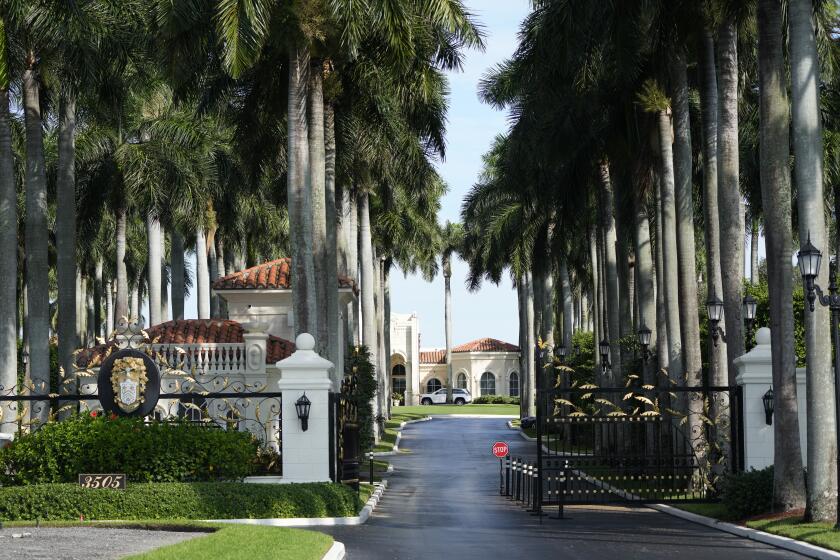President Seeks to Revive a Region -- and His Image
Four years ago, following the terrorist attacks of Sept. 11, President Bush won the admiration of most Americans -- including many who disagreed with his policies -- for resolute leadership in the face of a foreign threat.
That profile of Bush as a strong leader became the central selling point of the president’s reelection campaign last year.
“I love taking on big issues, because I think that’s my job,” he said in 2004. “I think that’s why the people of the country put me in office. They expect a president to lead.”
By this week, after the federal government’s confused response to Hurricane Katrina, most Americans were no longer sure they had made the right decision. One poll found that 43% rated Bush as a strong leader, down from 73% after the Sept. 11 attacks.
Bush’s address to the nation from New Orleans on Thursday evening, his first full-scale speech on the disaster since Katrina swept the Gulf Coast 18 days ago, was Step 1 of the president’s hurricane recovery plan.
The speech, delivered before the improbably pristine and well-lighted facade of St. Louis Cathedral, included all the necessary elements of a post-disaster address: compassion for the victims, praise for their rescuers, a call on the nation to pull together, a promise that “we will do what it takes” to bounce back -- and a brief acknowledgment that federal preparations had fallen short.
More important over the long run, though, was how Bush said he planned to restore the Gulf Coast to human habitation and even economic health: massive federal spending, including direct government aid to the tens of thousands of evacuees and federally financed reconstruction of roads and schools, and an ambitious list of new programs bearing the stamp of what he has called the “ownership society” -- federal money helping individual job-seekers and entrepreneurs.
“It is entrepreneurship that creates jobs and opportunity,” Bush said, “and we will take the side of entrepreneurs as they lead the economic revival of the gulf region.”
The president and his aides refused to put even a rough price tag on their proposals, apparently in hopes of minimizing opposition from increasingly alarmed budget-cutters in their party. Budget experts guessed that the cost, already mounting by an estimated $2 billion a day, could eventually approach $200 billion -- a price in the same ballpark as the wars in Iraq and Afghanistan.
But among many Republicans, the fiscal cost of rebuilding the Gulf Coast appeared modest compared with the potential political cost of appearing tight-fisted in the face of suffering.
“He can come down firmly on the side of bold dramatic change, in which case he will be in the Teddy Roosevelt tradition, or he can tolerate bureaucratic inadequacies and defend the indefensible, in which case the Democrats will win in 2006 and 2008,” said Newt Gingrich, a former speaker of the House.
“He has to be a problem-solver, and if it requires money, you have to do it,” said Kenneth M. Duberstein, who served as chief of staff to President Reagan. Appearing unresponsive, he added, is “the last thing they can risk.”
“If some of your base gets unhinged -- well, you can always make the argument that it’s better for a Republican to do it than a Democrat,” Duberstein said.
But there was little sign of dissent from most of Bush’s Republican base in Congress, where members have been increasingly nervous about their party’s fortunes in next year’s midterm election.
Rep. Tom DeLay of Texas, the House Republican leader, even suggested that deficit spending on public works would be good for the economy -- a sentiment that once was thought to define the Democratic Party, not the GOP.
“It is right to borrow to pay for it,” DeLay said. “But it is not right to attack the very economy that will pay for it.”
The president’s speech left several questions unanswered in addition to the price tag. Bush said nothing about the limits of federal generosity, beyond observing that a team of inspectors general would be deployed to make sure the aid was being spent “honestly and wisely.”
Nor did he announce the appointment of a reconstruction czar, as some had called for, to coordinate federal projects in the disaster zone. Officials have said that the issue of how to administer the programs is still being debated.
Nor did Bush weigh in on the question of whether the Federal Emergency Management Agency, which has been blamed for much of the chaos in initial relief efforts, should be disentangled from the giant Department of Homeland Security and restored to its former status as an elite independent agency.
But the president and his aides offered considerable detail on the menu of new programs they planned to propose to help the people of the Gulf Coast rebuild their homes and businesses -- an enterprise zone stretching across three states.
Those proposals include a Gulf Opportunity Zone, offering tax incentives and loans for small businesses; Worker Recovery Accounts, providing as much as $5,000 a person for education, job training and child care; and an urban homesteading initiative, giving federally owned property to aspiring homeowners through a lottery.
Those ideas are, in effect, disaster-relief versions of proposals Bush made during his first term and in his 2004 campaign -- proposals for urban enterprise zones, home-ownership subsidies for low-income families and job-training accounts.
Those programs, known collectively as the “ownership society,” have not fared especially well in Congress so far. The first phase, Bush’s proposal for sweeping changes in Social Security, appears to be dying a quiet legislative death.
Hurricane Katrina may have offered the ideas a new lease on life. But it was not clear how far Bush’s proposals would go toward restoring all the homes and jobs that have been lost.
The homesteading program, for example, would not build new housing units, but would redistribute buildings already owned by the federal government. The Gulf Opportunity Zone would provide tax breaks to businesses that invest in equipment and buildings, but no direct subsidies for job creation.
Congress’ Democratic leaders, Sen. Harry Reid of Nevada and Rep. Nancy Pelosi of San Francisco, immediately criticized the proposals, saying they would make the disaster zone “a laboratory for ... ideological experimentation.”
And whether Bush’s proposals will also restore his aura of leadership remains to be seen.
“It’s big events that move public opinion on issues and ideology and leadership ... not just speeches,” said pollster Andrew Kohut, president of the nonpartisan Pew Research Center for the People and the Press. “Take Bush himself: His strong image was forged in the days after Sept. 11, a momentous event. Now I think it’s been significantly undermined in the days following another momentous event. It’s hard to have rhetoric change public opinion the way these events can.
“What’s going to happen here to change people’s views about Bush’s effectiveness? If the federal government does a remarkably good job at repairing the Gulf Coast, maybe. But that’s the sort of thing that takes time to do.
“He’s going to have to catch a lot of breaks, and he’s got to try to achieve something not only [now], but for the rest of his term,” Kohut said.
*
Times staff writer Janet Hook contributed to this report.
More to Read
Get the L.A. Times Politics newsletter
Deeply reported insights into legislation, politics and policy from Sacramento, Washington and beyond. In your inbox three times per week.
You may occasionally receive promotional content from the Los Angeles Times.











